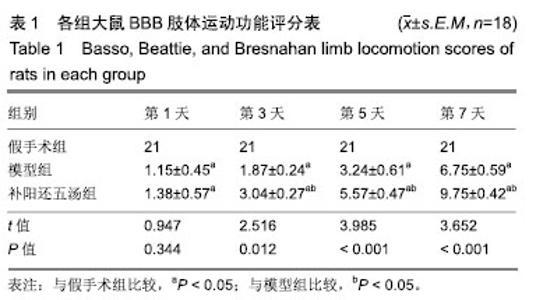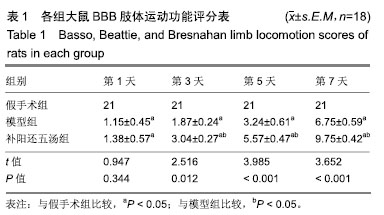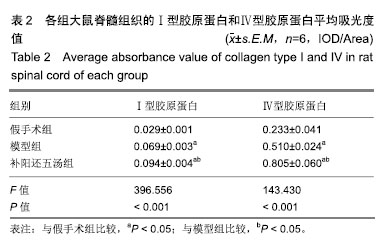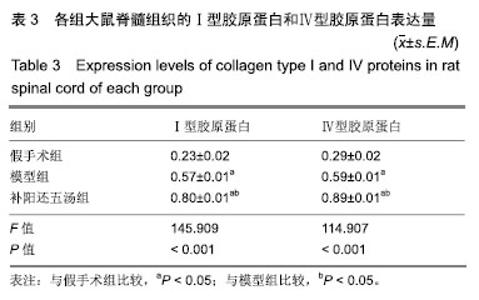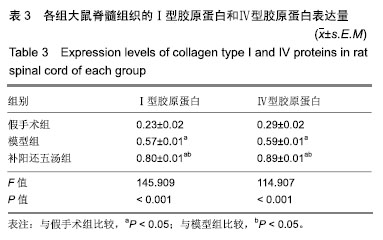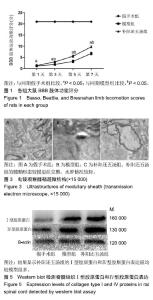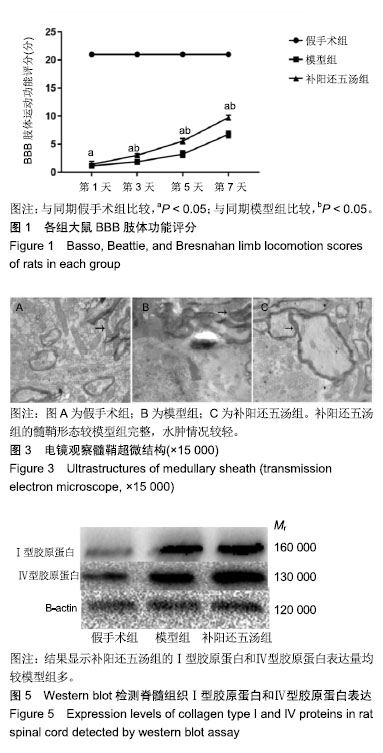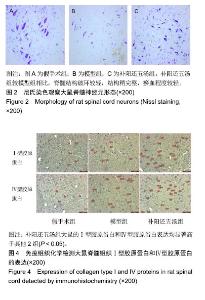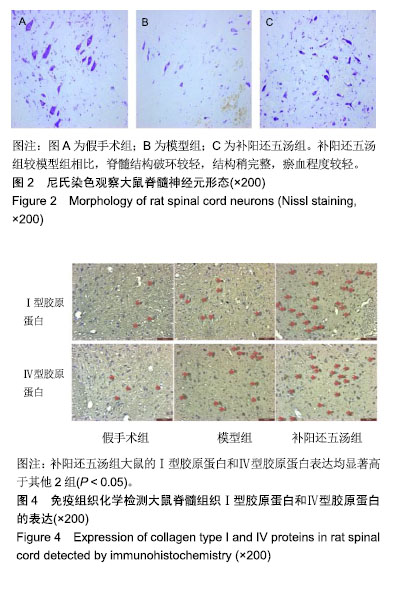| [1]Sharifalhoseini M ,Rahimimovaghar V. Hospital-based incidence of traumatic spinal cord injury in tehran, iran. Iran J Public Health. 2014; 43(3):331-341.[2]李念龙,于占革.骨髓间充质干细胞移植治疗脊髓损伤的研究进展[J].中国矫形外科杂志,2012, 20(4):343-345.[3]袁慧萍.中西医结合治疗急性脊椎损伤45例疗效观察[J].中国中医急症, 2013,22(8):1386-1387.[4]祁健,张俊江,孟庆溪,等.脊髓损伤的病理变化及治疗进展[J].现代生物医学进展, 2017, 17(21):4179-4183.[5]Boulenguez P ,Vinay L.Strategies to restore motor functions after spinal cord injury. Curr Opin Neurobiol. 2009;19(6):587-600. .[6]成军. 细胞外基质的分子生物学与临床疾病[M].北京医科大学出版社, 1999.[7]郭文荣,李兴.糖尿病肾病与ADPN?TGF-β1?Collagen IV?ICAM-1关系的研究进展[J].医学研究杂志,2015,44(6):170-173.[8]Kurt G, Yildirim Z, Cemil B ,et al.Effects of curcumin on acute spinal cord ischemia-reperfusion injury in rabbits. Laboratory investigation. J Neurosurg Spine. 2014 ;20(4):464-470.[9]石杜鹃,凌丽,薛金伟.补阳还五汤药浴对大鼠周围神经损伤再生影响的实验研究[J].时珍国医国药,2008,19(5):1066-1067.[10]Chen WF, Chen CH, Chen NF,et al.Neuroprotective Effects of Direct Intrathecal Administration of Granulocyte Colony-Stimulating Factor in Rats with Spinal Cord Injury. CNS Neurosci Ther. 2015;21(9):698-707. [11]范筱,吴杨鹏,汪今朝,张俐.活血通督汤对脊髓损伤后BDNF/TrkB信号表达的影响[J].中华中医药杂志,2017,32(05):2115-2120.[12]汪今朝,范筱,张俐.活血通督汤对脊髓损伤后胶质瘢痕形成的影响[J].中国中医骨伤科杂志,2017,25(8):1-5.[13]侯兆阳,陈哲,魏家森.补阳还五汤对急性脊髓损伤模型大鼠神经细胞凋亡的影响[J].浙江中西医结合杂志, 2015,25(01):8-11+106.[14]Bareyre FM. Neuronal repair and replacement in spinal cord injury. J Neurol Sci. 2008;265(1-2):63-72. [15]吴杨鹏,范筱,张俐.急性脊髓损伤动物模型的建立与评估[J].中国组织工程研究,2016,20(49):7341-7348.[16]Volarevic V, Erceg S, Bhattacharya SS,et al.Stem cell-based therapy for spinal cord injury. Cell Transplantation.2013;22(8):1309-1323.[17]Young W. Spinal cord contusion models. Prog Brain Res. 2002;137: 231-255.[18]Doble A. The role of excitotoxicity in neurodegenerative disease: implications for therapy. Pharmacol Ther. 1999;81(3):163-221..[19]Xiong Y, Rabchevsky AG, Hall ED. Role of peroxynitrite in secondary oxidative damage after spinal cord injury. J Neurochem. 2007;100(3): 639-649.[20]Engelhardt B, Sorokin L. The blood-brain and the blood-cerebrospinal fluid barriers: function and dysfunction. Semin Immunopathol. 2009 ; 31(4):497-511.[21]Erbayraktar Z, Gökmen N, Y?lmaz O,et al.Experimental traumatic spinal cord injury. Methods Mol Biol. 2013;982:103-112.[22]Gelse K, Pöschl E, Aigner T. Collagens-structure, function, and biosynthesis.Advanced Drug Delivery Reviews.2003;55(12): 1531-1546.[23]Giannelli G,Bergamini C,Marinosci F,et al.Clinical role of MMP-2/TIMP-2 imbalance in hepatocellular carcinoma. Int J Cancer. 2002;97(4):425-431.[24]Sweeney SM, DiLullo G, Slater SJ, et al.Angiogenesis in Collagen I Requires α2β1 Ligation of a GFP*GER Sequence and Possibly p38 MAPK Activation and Focal Adhesion Disassembly. J Biol Chem. 2003;278(33):30516-30524 [25]Verrecchia F, Mauviel A. TGF-beta and TNF-alpha: antagonistic cytokines controlling type I collagen gene expression. Cell Signal. 2004;16(8):873-880.[26]张峻,季欣然,唐佩福.应用生物材料促进脊髓损伤修复的研究进展[J].中国骨与关节杂志,2017,6(4): 309-312.[27]Cardoso FL, Brites D, Brito MA.Looking at the blood-brain barrier: molecular anatomy and possible investigation approaches. Brain Res Rev. 2010;64(2):328-363.[28]Takigawa T, Yonezawa T, Yoshitaka T, et al.Separation of the perivascular basement membrane provides a conduit for inflammatory cells in a mouse spinal cord injury model.J Neurotrauma.2010;27(4): 739-751.[29]Xian-Hui D, Xiao-Ping H, Wei-Juan G. Neuroprotective effects of the BuyangHuanwu decoction on functional recovery in rats following spinal cord injury. J Spinal Cord Med. 2016;39(1):85-92.[30]张继平,王志彬,林爱华,等.补阳还五汤对脊髓损伤大鼠脊髓组织血小板活化因子含量的影响[J].中国中医药信息杂志, 2011,15(11): 47-49.[31]张继平,王志彬,林爱华,等.补阳还五汤对脊髓损伤大鼠脊髓组织病理学的影响[J].中国中西医结合外科杂志,2014,20(3): 274-277.[32]陈安,廖君,熊艾君,等.补阳还五汤对脊髓损伤后胶质瘢痕及GFAP表达的影响[J].世界中西医结合杂志, 2007, 2(10): 570-572.[33]陈安,张建伟,伍校琼,等.补阳还五汤对红核脊髓束横断后神经元的保护作用[J].中国临床解剖学杂志, 2007,25(6): 665-668.[34]王伟,谢杰,方坚,等.补阳还五汤对实验性脊髓损伤大鼠水通道蛋白-4表达的影响[J].中国康复,2005, 20(1): 3-5. |
